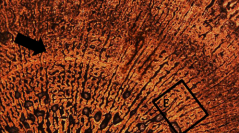

 Comptes Rendus Palevol
16 (4) - Pages 397-424
Comptes Rendus Palevol
16 (4) - Pages 397-424Shared histological characteristics have been observed in the bone matrix and vascularity between Ophiacodontidae and the later therapsids (Synapsida). Historically, this coincidence has been explained as simply a reflection of the presumed aquatic lifestyle of Ophiacodon or even a sign of immaturity. Here we show, by histologically sampling an ontogenetic series of Ophiacodon humeri, as well as additional material, the existence of fibrolamellar bone (FLB) in the postcranial bones of a pelycosaur. Our findings have reaffirmed what previous studies first described as fast growing tissue, and by proxy, have disproven that the highly vascularized cortex is simply a reflection of young age. This tissue demonstrates the classic histological characteristics of true FLB. The cortex consists of primary osteons in a woven bone matrix and remains highly vascularized throughout ontogeny, providing evidence for fast skeletal growth. Overall, the FLB tissue we have described in Ophiacodon is more advanced or “mammal-like” in terms of the osteonal development, bone matrix, and skeletal growth than what has been described thus far for any other pelycosaur taxon . With regards to the histological record, our results remain inconclusive as to the preferred ecology of Ophiacodon due to a similar cortical vascularity pattern exhibited by other carnivorous pelycosaurs. Our findings have set the evolutionary origins of FLB and high skeletal growth rates back approximately 20 million years to the Early Permian, and by phylogenetic extension perhaps the Late Carboniferous.
BCBB, C, EC, EFS, Fm, FLB, HL, L, LAG, LB, MC, MR, MOS, OL, PFB, RCBB, RSC, SF, WB, WPC